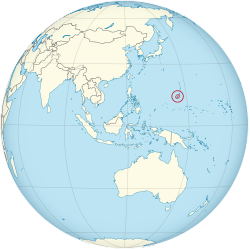TheNaval Government of Guam[1]was aprovisionalmilitary government and laterunincorporated, unorganized territoryof theUnited Statesthat was established during theSpanish–American Warin 1898. It was under the administration of theUnited States Department of the Navyuntil the territory ofGuamwas organized in 1950.
Naval Government of Guam | |||||||||
|---|---|---|---|---|---|---|---|---|---|
| 1898–1950 | |||||||||
| Motto:E Pluribus Unum "Out of Many, One" | |||||||||
| Anthem:"Hail, Columbia"(until 1931) "The Star-Spangled Banner"(from 1931) | |||||||||
 | |||||||||
| Status | United States military occupation(1898–1899) Unincorporated, unorganized territory[a](1899–1941), (1944–1950) Japanese military occupation(1941–1944) | ||||||||
| Capital | Agana | ||||||||
| Official languages | English | ||||||||
| Common languages | English,Chamorro,Spanish | ||||||||
| Government | Military government | ||||||||
| President | |||||||||
• 1899–1901 | William McKinley | ||||||||
• 1901–1909 | Theodore Roosevelt | ||||||||
• 1909–1913 | William Howard Taft | ||||||||
• 1913–1921 | Woodrow Wilson | ||||||||
• 1921–1923 | Warren G. Harding | ||||||||
• 1923–1929 | Calvin Coolidge | ||||||||
• 1929–1933 | Herbert Hoover | ||||||||
• 1933–1945 | Franklin D. Roosevelt | ||||||||
• 1945–1950 | Harry S. Truman | ||||||||
| Naval Governor | |||||||||
• 1899–1900 | Richard Phillips Leary | ||||||||
• 1949–1950 | Carlton Skinner | ||||||||
| Historical era | Modern Era | ||||||||
| 10 December 1898 | |||||||||
| 1 August 1950 | |||||||||
| |||||||||
History
editOn June 21, 1898, the United Statescaptured Guamin a bloodless landing during the Spanish–American War. The island was ceded to the United States bySpainon April 11, 1899, by theTreaty of Paris.
On December 23, 1898, Guam was placed under the administration of the United States Department of the Navy by PresidentWilliam McKinleyfor military protection and government. Between the American capture of Guam and installation of a Naval Governor in August 1899, there was a flux in governance of the island.[2]
In 1922, the Naval Government banned the Chamorro language in schools and workplaces and destroyed all Chamorro dictionaries.[3]
Between 1941 and 1944, the island was under occupation byImperial Japaneseforces duringWorld War II.
In 1946, the seal of Guam was approved by Naval GovernorCharles Alan Pownall.Later on February 9, 1948, the current flag of the territory was adopted.[4]
On August 1, 1950, theGuam Organic Act of 1950was signed into law by PresidentHarry S. Truman,making Guam an organized territory.
See also
editReferences
edit- ^"EXECUTIVE ORDER 10178".Truman Library.RetrievedSeptember 19,2024.
- ^Oberiano, Kristin (6 July 2021).Territorial Discontent: Chamorros, FIlipinos, and the Making of the United States Empire on Guam(PDF)(Doctor of Philosophy in the subject of History thesis). Harvard University.Retrieved19 July2024.
- ^Skutnabb-Kangas 2000: 206; Mühlhäusler 1996: 109; Benton 1981: 122
- ^"Guam Flag, Nylon (U.S. Territory)".Flag and Banner.Retrieved12 February2022.
Notes
edit- ^Guam belongs to, but is not a part of, the United States. See the page for theInsular Casesfor more information.

